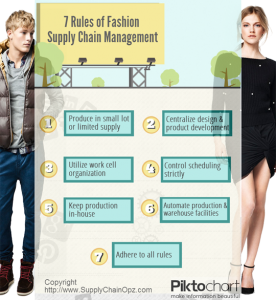- December 17, 2014
- 3:26 pm
- John Caltagirone
- no comments
Zara’s Fast-Fashion and Even Faster Supply Chain
Everyone knows Zara as the Spanish owned retail legend that has been leading fast-fashion with its chic, street-fashion, but more impressive is his supply chain management.
Fashion is already a difficult industry to operate in. It is unpredictable and uncertain. Rapidly the push from fashion companies driving their own styles is fading into companies conforming to consumer wants.
Zara has been impeccable at keeping up with the latest trends and being consumer-driven. With around 30% of garments produced in the world exported in developing nations, the costs of transportation and manufacturing, Zara has found an edge.1
It uses a pull model with inventory and supply chain management in which the often create about 1,000 designs per month using sales information and current trends. According to a 2010 Zara case study done at Columbia Business School, Zara is able to prepare clothing 6 months in advance to create about 40% to 60% of their seasonal lines.2 Moreover, around 80% of the season’s inventory is manufactured prior to the season.
Zara is advantageous in the sense they have the ability to produce in-house and allow for its own factories to reserve 85% of their capacity for in-season adjustments.2 The items that have long lead time, Zara uses the same foreign factories as other companies to reduce the cost.
Furthermore Zara reduces its risk by producing small batches of each product and maintaining a quick turnover rate, allowing them to measure the success and acceptance rate of each design in the market. In fact, the company intentionally does this to build exclusivity of its brands, switching out stock every two weeks to drive consumers to buy limited styles.3 Lastly, Zara fully optimizes its distribution chain by shipping all the clothing to Spain and distribute it from the central location based on the preferences of the countries and stores.
Below are the 7 Rules of Supply Chain to showcase the success of Zara:
– Riti Patel, Assistant, Supply and Value Chain Center
- http://www.supplychain247.com/article/zaras_fashion_retail_supply_chain_strategies/gt_nexus
- http://www.slate.com/articles/arts/operations/2012/06/zara_s_fast_fashion_how_the_company_gets_new_styles_to_stores_so_quickly_.html
- http://www.nytimes.com/2012/11/11/magazine/how-zara-grew-into-the-worlds-largest-fashion-retailer.html?pagewanted=all
